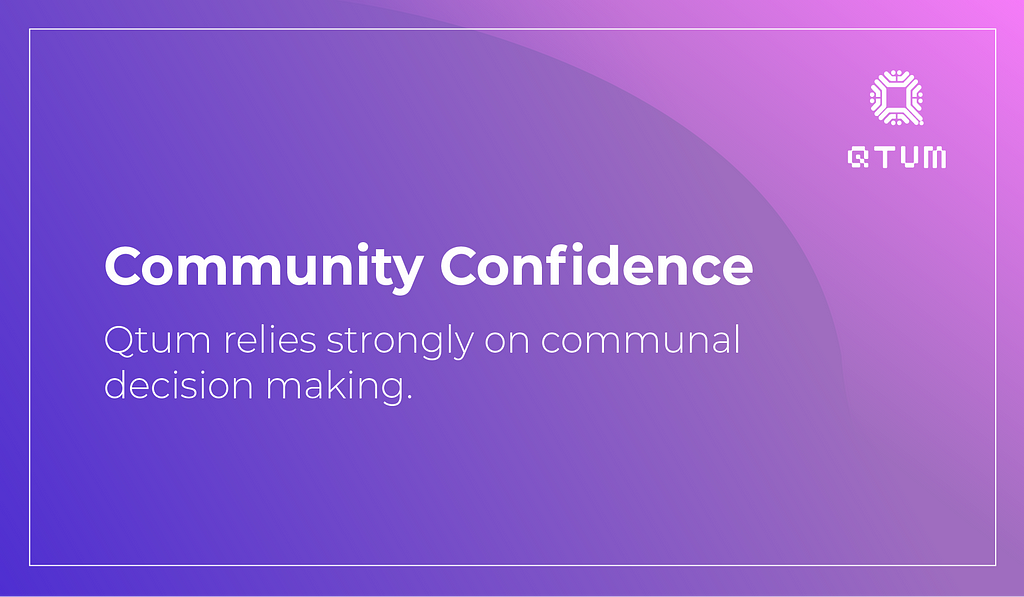Qtum: Community Confidence
0
0

Qtum is a decentralized smart contract blockchain based on Bitcoin Core that uses a Proof-of-Stake consensus mechanism.
Through the use of a middleware adapter called the “Account Abstraction Layer,” Qtum is able to host the latest version of the Ethereum Virtual Machine on top of our clone of Bitcoin Core.
Qtum is also able to adjust the cost of gas and block size without requiring a hard fork. This allows Qtum to remain inexpensive during times of high usage.
Qtum’s throughput, or transactions per second, can be anywhere from 1100 on the layer1 chain or “millions to billions” if using a layer2 solution similar to Lightning or using layer3 like Opside, building on Qtum.
Since 2016, the Qtum development team has worked on improving the core platform. To date, there have been over 40 software updates, including multiple hard forks.
Qtum is a fork of Bitcoin, which allows us to keep upstream with the latest “Bitcoin Improvement Proposals” without having to reinvent the wheel each time we want to have comparable functionality.
The main advantage of the Qtum blockchain is the fact that it’s completely decentralized. This means that anyone who wants to participate in the validation process can do so only by leaving his or her wallet online.
There’s no requirement to purchase Qtum tokens. You simply need the Qtum software and an Internet connection.
Because of this decentralization, there’s also no way for the Qtum team to pause, halt, or roll back the blockchain.
We rely on the confidence of the community to accept our software updates, but it’s the community that ultimately decides whether the software we develop gets adopted as the main chain.
The Qtum community can be literally anyone who has an opinion on the project. This means developers, service providers, node operators, stakers, scrutineers, random people on Telegram, etc.
It doesn’t have to be individuals who hold tokens, the democratic process regarding whether a software update is accepted or not is based on who adopts it and who doesn’t.
It’s not a winner-take-all process either, if an individual or group of people, for whatever reason, want to run nodes and validate transactions on the old chain, there’s no one to stop them.
Confused yet? Ok, then, let’s break this down:
The Qtum development team consists of blockchain coders who are paid by the Qtum Foundation to work on the core blockchain. They don’t get paid by the community, nor do they raise funds, stake, or dump (premine) coins to receive their salaries.
The money comes from the March 2017 crowdsale. The agreement was that Qtum would develop the blockchain for 4 years.
When the Qtum development team publishes an update, the source code becomes available on GitHub. Let’s call this update “Qtum Latest.”
Service providers, like centralized exchanges, typically release a notice that states whether or not they will implement the latest Qtum update.
Usually, once the biggest exchanges post that notice, all of the other service providers that support Qtum will also follow suit and adopt the update to “Qtum Latest.”
Any other community members who want to make use of these service providers (who adopted the update) will also need to update to “Qtum Latest.”
If node operators and exchanges decide not to update to “Qtum Latest,” then they will be running an older version of Qtum and become a fork.
They can continue to develop this chain and publish their own updates. They can try to convince exchanges not to update and stay on the old chain.
This would be considered a community split, and the chain would likely be named something like “Qtum Classic” or whatever they want to call it.
This is loosely similar to how Ethereum Classic and Bitcoin Cash came to exist. Community disagreement(s) about the direction of the project resulted in multiple “forks” of the chain.
When chains like Bitcoin, Ethereum, and Qtum are truly decentralized, there is literally no one in charge, and it comes down to community confidence to accept whatever software updates they want from whatever team they agree with.
Summary
The Qtum development team publishes frequent updates to GitHub. Much of this work involves blending in the Bitcoin Core and Ethereum Virtual Machine updates to the Qtum Core.
When this happens, the community has a choice whether to adopt these updates or reject them.
There is no central decision-making entity at Qtum that forces users to adopt changes to the blockchain.
Service providers like exchanges and wallets, along with community members, decide if they want to accept these updates.
It’s possible for some or all of the community to ignore or reject the Qtum development team’s updates and continue to use the original chain, which could lead to there being multiple forks of Qtum.
The Qtum development team depends on the confidence of the community to accept updates. In the absence of updates from the development team, the network could survive indefinitely simply because the source code is easily available, and it’s the community that runs the nodes that keep the chain healthy.
0
0






